
NEON FUSION TD
GAME DESIGN
PROGRAMMING
Tower Defence
Unity 2022
Trello
5 weeks
Group Project (5)

ABOUT THE GAME
MAIN FEATURES
-
Mobile tower defense set in a mystic cyber realm where players battle a digital virus threatening to consume the system
-
From the first wave, players must think tactically: placing turrets, managing limited resources, and adapting to evolving enemy threats
-
Unique fusion mechanic replaces traditional upgrades, letting players merge base tower types into powerful hybrid defenses
-
Each fusion unlocks new tactical possibilities, encouraging experimentation, creativity, and personalized strategies
-
Enemy variety and intense boss encounters keep the pressure high and strategies fresh
-
Designed for mobile with smooth performance and intuitive controls that support quick decision-making
MY KEY CONTRIBUTIONS
Click on the name of a section to jump there!
-
Designing core gameplay systems including all towers, projectiles, and debuff mechanics
-
Programming tower behaviors and combat interactions to support fusion mechanics
-
Structuring player progression through both complexity scaling and difficulty scaling
-
Balancing enemies and towers for challenge and fairness, using spreadsheets for tower damage and values
-
Organizing and leading playtests to refine tower fusion strategies and difficulty pacing
-
Collecting feedback, adjusted values, and fine-tuned mechanics to ensure engaging but fair gameplay
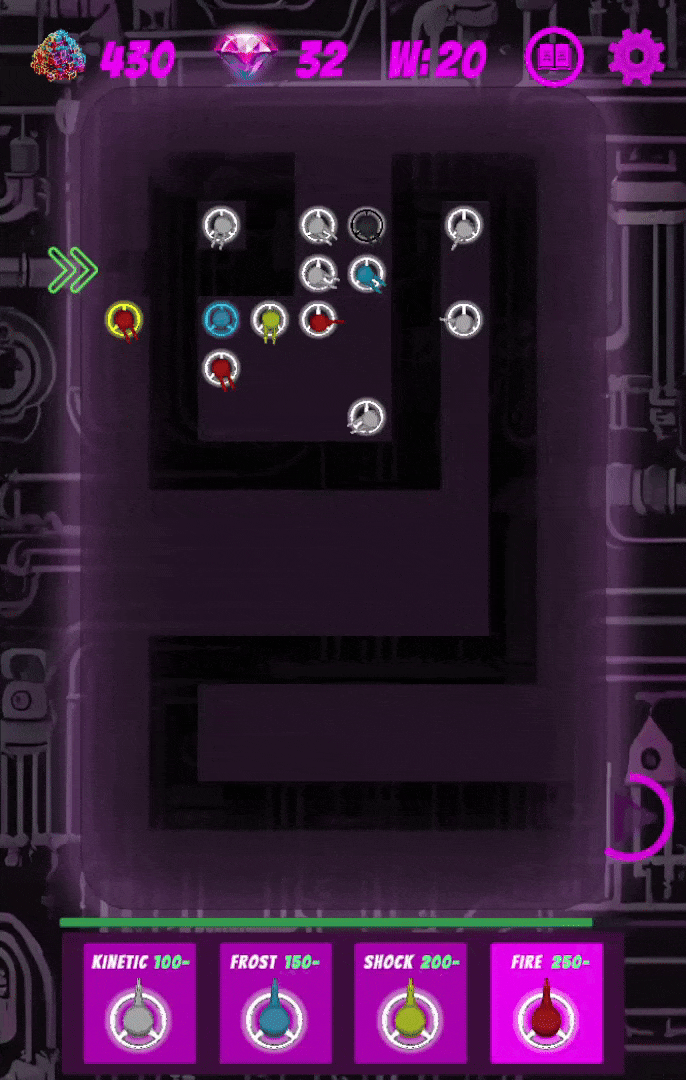
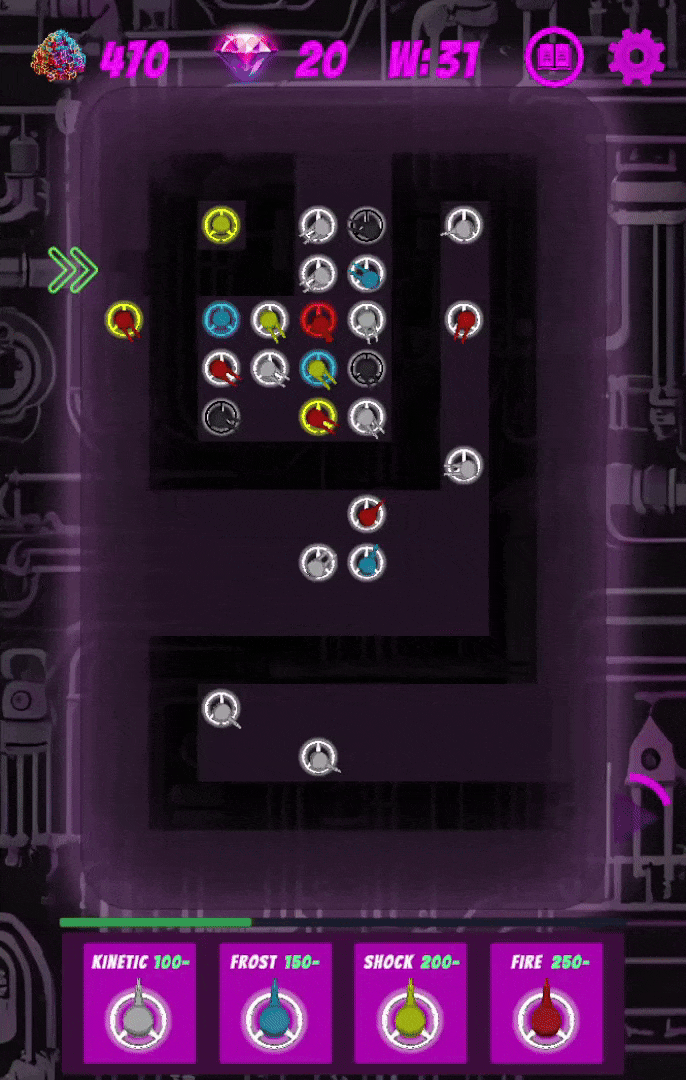
DESIGN CHALLENGES
MAKING TOWERS FEEL UNIQUE YET APPROACHABLE
-
Goal: Give players a wide range of tactical tools through merging, while ensuring the system didn’t become overwhelming or confusing.
-
Solution: I created towers around clear archetypes (normal, frost, fire, shock) and used merges to layer complexity. Pure merges double down on a strength, while cross-merges create hybrid strategies. Iteration and playtesting shaped balance so players feel encouraged to experiment without getting lost.
-
Takeaway: Distinct archetypes give players clarity, while controlled merges keep depth from spiraling into chaos.
HANDLING EDGE-CASE DESIGNS
-
Goal: Explore whether experimental mechanics (like the Obsidian Tower’s backward-push effect) added strategic depth or just broke the flow.
-
Solution: I iterated heavily, testing variants with boss damage and control effects before landing on a situational niche design. This forces critical decisions about how unpredictable or “wildcard” a tower should be in a balanced system.
-
Takeaway: Experimental designs can be valuable, but they need to serve the broader system. Sometimes a mechanic works best when it fills a narrow role instead of competing with core options.
BALANCING AREA OF EFFECT TOWERS
-
Goal: Deliver AoE towers that feel satisfying against swarms without trivializing encounters or invalidating other strategies.
-
Solution: I introduced target caps to Tesla and Flamethrower towers, preserving their swarm-clearing fantasy while keeping them fair against single enemies and bosses.
-
Takeaway: AoE design is about giving players power and creativity while adding limits to maintain long-term balance.
Game Design & Programming
TOWER DESIGN & FUSION MECHANICS
Primary doing design and programming, my focus was on creating towers that were intuitive, visually readable, and strategically meaningful, tying directly into the fusion-based progression described in the main features. Each tower needs to feel distinct on its own while also providing meaningful options when combined, ensuring that experimentation remains rewarding rather than confusing.
Each base tower: Kinetic, Frost, Shock, and Fire is designed with a clear archetype so players can immediately understand its function and role in the overall strategy. Merges between towers produce hybrid defenses that reinforces tactical creativity, allowing players to adapt to evolving enemy waves and encouraging them to discover synergies organically.
This approach addresses the design challenge of making towers engaging without overwhelming players with complexity. For example, combining two Frost Towers produces the Arctic Tower, applying a heavier area-of-effect slow that controls enemy movement without dealing direct damage, while merging Fire and Shock Towers create a hybrid that applies Burn to multiple targets simultaneously, dealing moderate damage while also weakening groups of enemies.
Other merges, like Kinetic-Frost or Kinetic-Fire, enhance attack speed or add secondary effects, giving players flexibility in shaping their defense based on both immediate needs and long-term strategy. These combinations encourage players to experiment and innovate, finding unique solutions for each wave while reinforcing the non-linear progression system.
Careful balancing of damage, effect durations, and crowd control ensure each tower and merge feels purposeful, strategically viable, and align with the broader design challenge of maintaining depth, accessibility, and meaningful decision-making throughout the game.
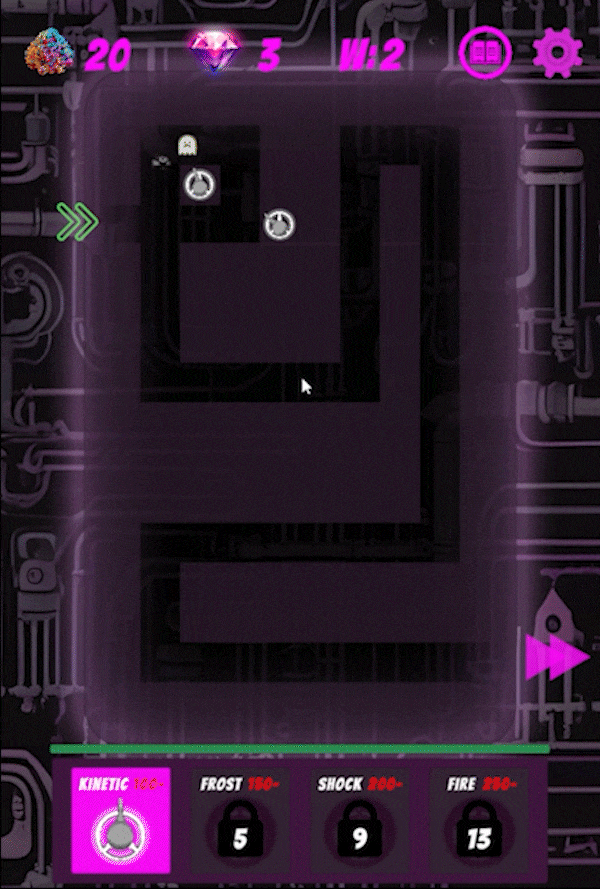

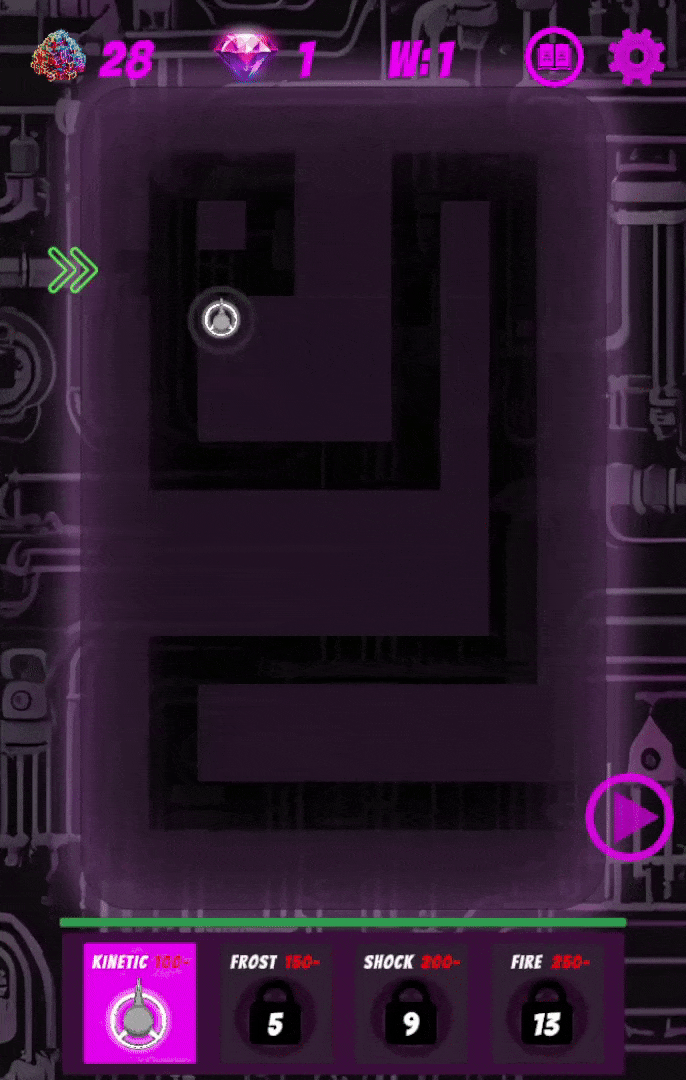
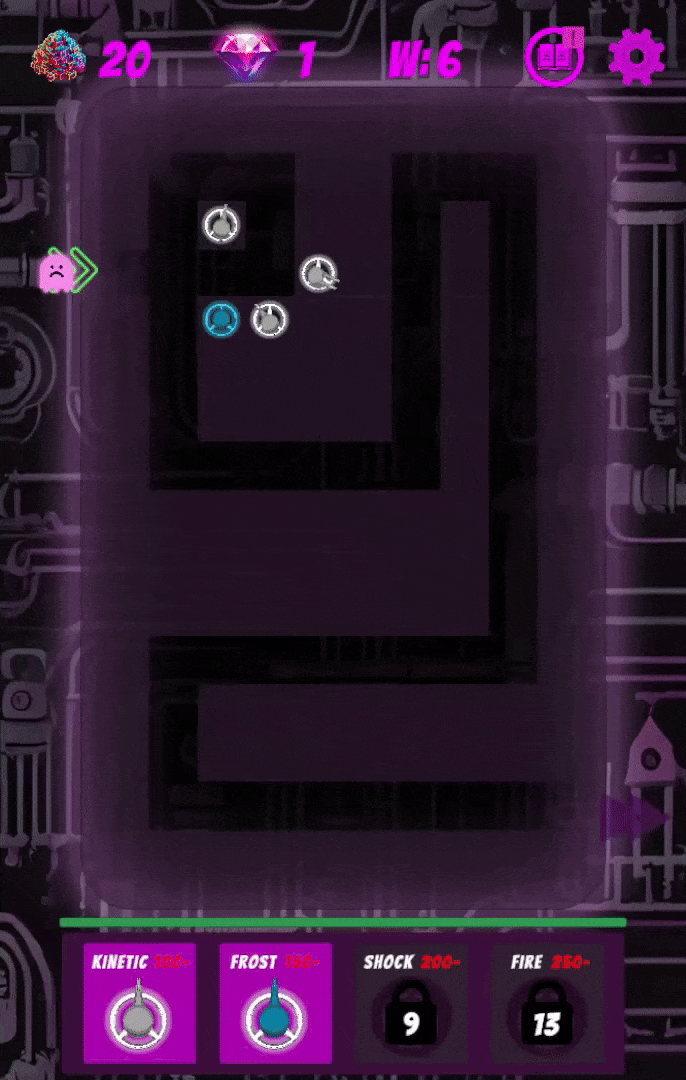


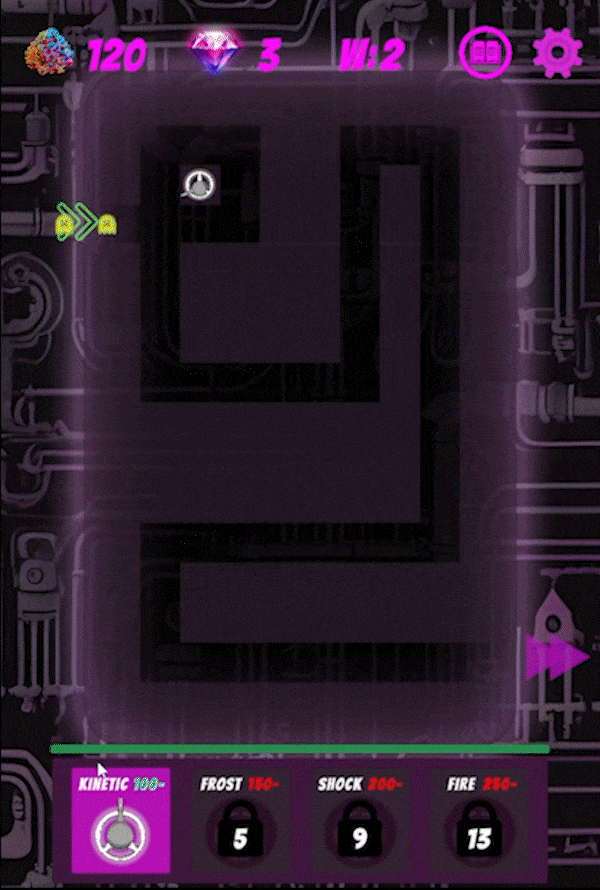
ADDITIONAL SYSTEMS IMPLEMENTATION
Alongside tower mechanics, I implemented some underlying systems that make the gameplay responsive, consistent, and adaptable for mobile platforms.
Enemy health, wave progression, and stat management are modularly structured, enabling towers, merges, and debuffs to interact predictably while supporting experimentation. Systems for merge currency, shop pricing, and round-based scaling ensure resource management remains meaningful, reinforcing strategic decision-making under pressure.
Additional features like game-speed toggles, auto-play next wave, and audio manager were implemented to improve accessibility and player control, while also allowing rapid iteration on towers and merges.
These systems support the core gameplay loop, ensuring players can engage with the evolving enemy types, discover hybrid tower synergies, and apply creative strategies to overcome increasingly complex waves.
Referring back to the design challenges, these systems are crucial for balancing experimentation, fairness, and clarity, ensuring that every player choice has a tangible tactical impact.
Progression & Onboarding
A key focus was ensuring the game’s progression felt smooth and intuitive, gradually introducing complexity without overwhelming players. Early rounds start with only one tower available and enemies are introduced one at a time in smaller waves. Merging mechanics are unlocked a few waves in, allowing players to experiment once they’ve become comfortable with the basics.
The first boss serves as an approachable challenge, easing players into more advanced tower strategies. Defeating it unlocks the Frost Tower, opening new merging possibilities and encouraging experimentation with hybrid defenses. As additional towers become available, strategic complexity grows, rewarding players who explore synergies between single-target, AoE, and crowd control effects like Chill and Obsidian Towers.
To support player decision-making and strategic planning, we also implemented a system that allows towers to be repositioned between rounds. This adds another layer of tactical depth, encouraging players to optimize tower placement whilst not punishing a small mistake when first building it.

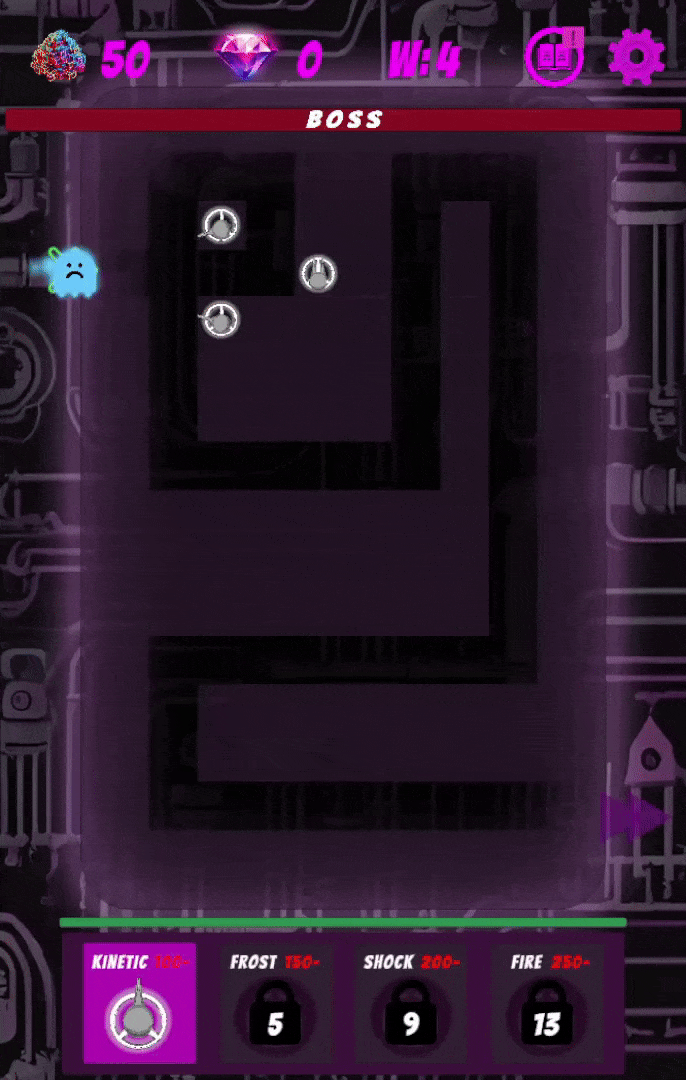
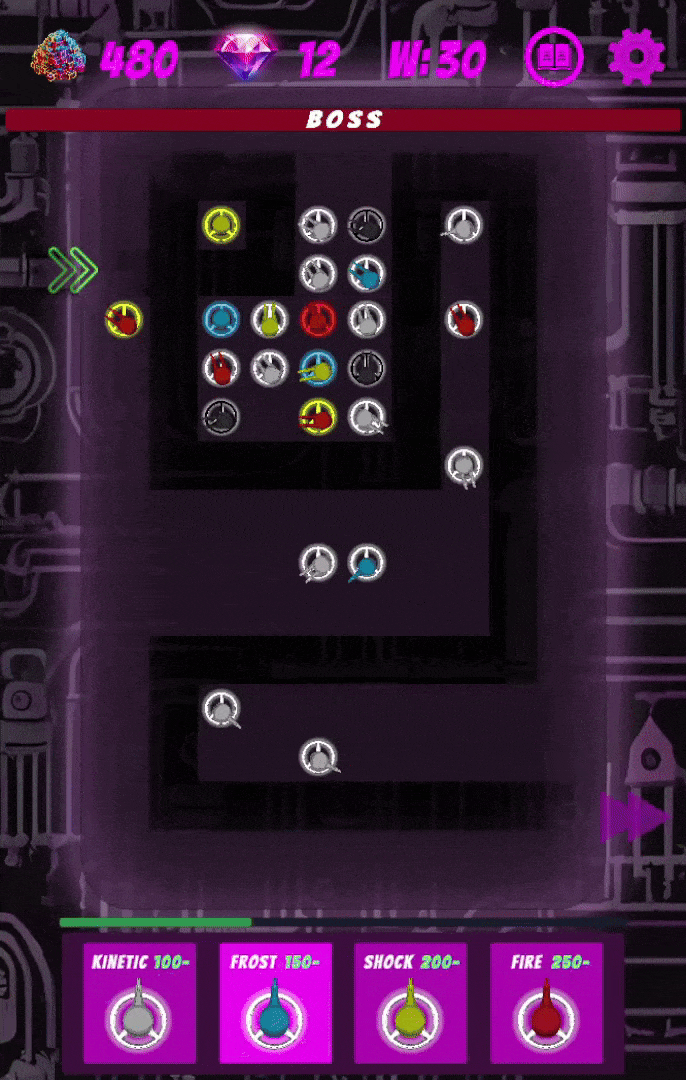

Iteration & Balance
Balancing towers and enemy waves required extensive playtesting and iterative adjustment. I made a Google Spreadsheet where I input the desired cost of the towers and played around with the Projectiles per Second (PPS), Damage and Burn Damage per Second values until I felt the Total Damage per Second per Bits (currency) among the towers felt reasonable.
Since the towers that apply the Burn debuff deal their damage over a longer period of time, these towers need to be the most efficient single target towers to buy. It also felt intuitive for the more expensive towers to be more efficient since it's a bigger investment to get them and as a player its more fun when the most expensive towers are powerful. Since the Chill debuff is very valuable utility, all towers that apply it also are a lot less damage per Bit efficient.
The towers that fire projectiles that chain or deal damage to multiple enemies at once (Flamethrower Tower) need to in a place where they are the most efficient towers against multiple enemies but on the weaker side against a single target. Lastly the Obsidian Tower's effect is inherently so strong against non-boss enemies that I decided against making it deal damage against bosses. In hindsight it might've been better to nerf its effect even more than I already did and instead also let it deal some damage against bosses.

Reflection & Learnings
DISCOVERING MY DRIVE FOR GAME DESIGN
Developing Neon Fusion TD with a larger team helped me find my strengths as a Game Designer. Seeing systems work together and watching players engage with towers and mechanics I designed was incredibly rewarding. The project reinforced my passion for designing meaningful systems and gameplay.
ORGANIZATION AND COLLABORATION
I gained a lot from structuring tasks, managing ideas in Trello, and coordinating with the team. Brainstorming mechanics, planning tower behaviors, and implementing systems were enjoyable, though I learned the importance of pacing myself. Regular breaks and clearer boundaries would have improved efficiency and overall well-being.
SCOPING AND PRIORITIZATION
Early in the project, we underestimated the scope, which made workload management and iteration more challenging. Focusing first on core systems in towers, fusion mechanics, and wave design would have allowed team members to concentrate on high-impact areas rather than peripheral tasks.
TECHNICAL AND DESIGN LEARNINGS
I refined my programming skills in Java, balancing towers, enemies, and progression while integrating a complex merging system. I also learned how to evaluate and iterate interactions systematically, balancing utility, damage, and niche effects. This process highlighted the importance of structured playtesting and continual refinement to maintain fun and fairness.
FINAL THOUGHTS
Neon Fusion TD strengthened my skills in system design, progression tuning, and collaborative game development. The project confirmed my enjoyment of crafting strategic mechanics and iterating through both design and programming challenges, giving me practical experience I can carry into future projects.


